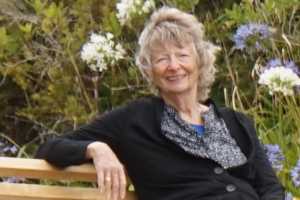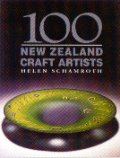|
|
|

|
|
home / latest designs / recent work / pohutukawa / beech / gingko
Information about my influences, life, home etc, and artistic statement.
Ruth Baird:I made no jewellery until 1969 when I went to a hobby class while I was living in London. Before that I had done a degree in languages, travelled, and worked in a library. After having a family, I returned to jewellery in about 1973 and joined Fingers when it began in 1974 - Alan Preston included me despite my protests that I didn‘t have enough time. Since then I have worked full-time making jewellery while raising my family in the green, moist surroundings of my home in Titirangi, Auckland. I had a craft background as a child and did a lot of knitting, sewing, crocheting and embroidery. I had no training in art or design, but did look closely at old jewellery in museums when I travelled. I particularly loved the harmonious colours and strong shapes of artefacts of the time of Tutankhamen, which I saw when I passed through Cairo in 1967. I also loved the sinuousness of the Art Nouveau jewellery of Lalique.
My inspiration for jewellery
begins from my feelings of joy in the landscape and the natural world (the
seaside when I lived near it, and now the bush and my garden), and my
interest in, and curiosity about, its processes, including the cycle of
death and regeneration. Many of the shapes and textures I use are derived
from nature. I prefer simple techniques, and using my hands, rather than machines: knitting, crochet, and more recently, twining and weaving, form a large part of my work. Apart from these, fabrication is my main construction technique - I mount titanium, niobium or shell in silver. The colours of my titanium and niobium work I get by anodising, whereby an oxide layer forms and appears as various colours according to minute variations in thickness. Then I use various grinding, punching or painting techniques to create a surface texture.
I try to make my work wearer-friendly
and comfortable, as it is intended to be worn by people who are attuned to
what I am doing. CV/Resumé (below)

Ruth Baird  
jewellery studio Auckland, New Zealand |
Reviews and Comments:
Contemporary New Zealand Jewelry by Jill Smith Jewelry is variously described as a 'decorative art,' a 'fashion item,' an 'object of status,' . . . or simply 'craft.' The pieces in my collection go well beyond these definitions to 'sculpture to wear', 'assemblage' and 'body art.' For me they are art works significant for the quality and design of their forms, the beauty of the materials, and their expression of ideas. There are necklaces celebrating connections to the land, Aotearoa - homages to our past. There are rings, brooches and badges - sculptural talismans of the present. All are treasures of the future. Most importantly they represent a reaction against the myth that "diamonds are a girl's best friend" and the kind of jewelry regarded as 'precious' in the Western world. The earrings and necklaces in my collection by Ruth Baird and Jenny Pattrick are fine examples of the use of paua. Other jewelers combine paua with bone, laminated shells and wood to make works strongly influenced by Pacific body adornment. The breast plates of Alan Preston and the canoe forms of Warwick Freeman clearly express the notion of jewelry as iconic statement and talisman. My passion for collecting jewelry by contemporary New Zealand art makers began the early l980s with a piece by Matthew von Sturmer which I affectionately call 'my little slices of New Zealand.' Lashed together with natural fibre dyed black are elongated 'slices' of river stone, paua shell and greywacke, startlingly accompanied by a wedge of fluorescent pink perspex reminiscent of a toothbrush handle. This meeting of nature with materials from the made environment has become one of the distinctive features of contemporary jewelry in Aotearoa. The influence on contemporary jewelers of New Zealand's position in the Pacific is paramount. From the beginning with the first voyagers from Polynesia the preoccupation was with materials evocative of land, sea and sky. They brought with them a culture based on nature. Bone, stone, shell, wood and fibre formed the basis of this culture. These materials were accorded value deriving from their use as tools, weapons, adornment, symbols of power, currency and status. The beautifully made pearl shell breast plates of Island Polynesia and the pounamu (nephrite jade) hei tiki and hei matau pendants of the Maori added to the mana (status) of their owner and their tribe. The traditions of the people of the Pacific and their ancestors, together with the traditions of 20th Century art makers have combined to provide a source of ideas and inspiration for contemporary jewelers. The use of natural an non-precious materials, and the presentation of found objects as body adornment began a style of innovative jewelry which has extended viewers' perceptions of what jewelry can be and what it can be made from. Non- precious materials are used in such as way as to give them artistic value in contrast with the material values of gold and diamonds. Of particular interest to me has been the imaginative and varied use of paua shell (a species of abalone) as a precious material for jewelers and as acknowledgement of New Zealand's bi-cultural heritage. (This is in strong contrast to the degraded use in crushed paua shell pendants, ash trays and 'kiwis' to be found in tourist outlets). Abalone is found all round the Pacific Rim but the strong blues and greens of the New Zealand variety are unique. Jill Smiih is Senior Lecturer in Art and Art History at the Auckland College of Education. She is an avid collecior of New Zealand art in all its forms. 'Across the Pacific' article, circa 1999 Jewellery at the artists-jeweller production level can now mean just about anything goes, and just how far can be seen in Contemporary Wearables 01, an exhibition of Australian and New Zealand jewellery ... ... New Zealand's Ruth Baird is another jeweller who exhibits a capacity for daunting perseverance and complexity in manufacture. Her 'Two Cuffs' have been crocheted from pure 0.3mm silver wire and set with four pure silver buttons. They have a singular Elizabethan elegance. Toowoomba 'Contemporary Wearables 01' competition and exhibition reviewed by Peter Ward, in The Weekend Australian, Feb 9-10, 2002. Elegant pendants, earrings and brooches by Ruth Baird take the form of pohutukawa leaves shimmering in colours of coloured titanium. Mounted on silver or hung from unusual necklets of knitted niobium wire, they have a distinctive New Zealand character. Review by Howard Williams in 'Around the Galleries' New Zealand Herald, Sat Dec 20, 1997 More in the middle of the market is the work of Brian Adam and Ruth Baird, who work from their studio in Titirangi's native bush on the outskirts of Auckland. 'We're in the low-intrinsic-value jewellery market,' says Baird, who works mainly in silver, titanium, paua and pearl shell. 'The New Zealand landscape inspires me. I've done a lot with nikau palms.' She bends over a set of titanium earrings borrowed from the fan-shaped leaves of the introduced gingko tree. Baird was one of the first New Zealand jewellers to discover how beautifully silver and paua shell blend together. Paua, once considered tacky, gains substance. Silver, sometimes in danger of being boring, glistens as though it has just emerged from the sea. And, not surprisingly, Baird's pohutukawa drop earrings are famed throughout the country. Adam, on the other hand, is one of New Zealand's more experimental and outrageous jewellers. His work includes fern sunglasses cast in silver from lacy native fern tendrils, corrugated iron and chunky paua glasses, and his paua and silver 'sputnik' earrings. Fortunately for whole generations of New Zealand jewellery students, his ideas and passions are being passed on through his classes ... 'The Art of Identity' By Carol Du Chateau Air New Zealand's 'Pacific Way', August 1994 'Knit 3 Together' is an apt title for this exhibition - three fibre artists using the ancient techniques of knitting and crochet, but with untraditional materials and end-pro ducts. There is not a shawl Or pink cardie in sight. Honouring the tradition of all those whose clicking needles produce garments for warmth, protection and decoration, these knitters make jewellery, sculpture about protection and paintings celebrating women. Ruth Baird's jewellery shows the least controversial adaptation of the techniques, because it is still wearable and extremely beautiful. It needs no clever titles and asks for no deep insights of understanding. Her pieces are all necklaces, tubes of crocheted wire forming flexible bands from which are suspended decorative shapes of paua shell set in silver, leaves in sheet silver, titanium or niobium. These metals are treated to repeat the rich colours of paua, iridescent blues and greens, or royal purples and vibrant reds. Leaves of the ginko tree are fashioned from silver, one necklace in hot purple and red, another in soft greens and amber, their bands crocheted from plain silver or colour matched to the pendants with graduated colour changes. Others hang with free form shapes or metal coils and beads, always in cool silver or the flamboyant high-tech colours, visually stunning, eminently wearable ... 'k3tog' at Masterworks Gallery reviewed by Howard Williams New Zealand Herald, Thu 24th Sept, 1992 |
Customer Endorsements:
I am proud owner
of one of your blue single leaf pendants and am wondering
if I am able to order another one off you to give to a dear friend of mine
for xmas. I get sooo many comments every time I wear it! I recently received the most exquisite engagement gift from my future parents-in-law. It is one of your hand crafted fine silver crocheted cuffs with little silver buttons. As I understand it, it is only one of two of its kind which were in an exhibition in Australia recently. ... Thank you for creating such a work of beauty. I look forward to designing my wedding gown with your special feature in mind. Majka, London. I am drawn to your work not just by it's beauty but by the significant heartfelt nature gone into the development of its form. Jennie The (replacement) brooch and earrings arrived yesterday and they are just beautiful. I suspect that the differences in the brooches is sufficiently subtle such that its original giver (being male) will never notice, so my secret is safe! And the curly catch works a treat. Thank you so much for getting this done so nicely and so promptly. Helen, Adelaide. Thank you for sending me the new necklace. It looks beautiful and elegant. I really appreciate how you've accommodated me. The next time my husband is in New Zealand I'm sending him back for more! Sincerely, Carmel, New York. I really love your work and find it very inspirational. Julie, Tauranga. Just a short note to say your jewellery arrived today safe and sound. Its beautiful as usual. I love the new earrings... All the best Bruce, Sydney. Hallo Ruth! I'm an italian sculptor. I've seen your jewels on your site. Complimenti! Giorgio, Italy |
